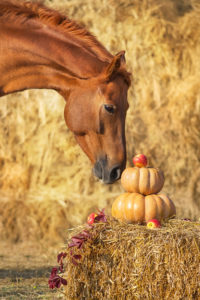 As we head into the Halloween weekend it may have got you thinking about what seasonal treats you can prepare for your horse. Many owners often ask if its ok to feed pumpkin and the simple answer to that is yes, the traditional orange pumpkin available throughout the fall is suitable. Butternut, zucchini and acorn squash are also nontoxic to horses.
As we head into the Halloween weekend it may have got you thinking about what seasonal treats you can prepare for your horse. Many owners often ask if its ok to feed pumpkin and the simple answer to that is yes, the traditional orange pumpkin available throughout the fall is suitable. Butternut, zucchini and acorn squash are also nontoxic to horses.
However be careful not to generalize all types of gourds, as green, yellow, white, striped, bumpy and smooth gourds can be potentially toxic and can lead to colic, diarrheas and gastrointestinal irritation.
The one thing to look at with any treat given, is what is the nutritional value of that feed item to the horse and could there be an issue?
The first area many people automatically consider is that of sugar content.
Pumpkin has around 1.7g per 100g as fed. If we consider this against other feed items such as carrots which have 7.4g per 100g and even grass which could have around 10g per 100g. Pumpkin therefore comes in fairly low.
The total NSC value (which is the sum of starch and sugars (water soluble carbohydrates)) of pumpkin comes in at around 10%, making it suitable for horses with conditions such as Equine Metabolic Syndrome, PSSM, Laminitis, Cushings etc. Its overall calorie content is also fairly low and therefore it can be useful in situations where calories are being monitored. However if your horse is on a calorie controlled diet, remember moderation is key and all the little treats add up over time so make sure you account for this when feeding.
One area of caution with pumpkin is that it provides 0.4g of potassium per cup. If we compare this to grass hays which provide around 8.5g per pound, this small amount per measured serving for the average horse, is nothing to be concerned about. However if you have a horse with HYPP (Hyperkalemic Periodic Paralysis), where limiting potassium intake is necessary, it might be wise to give the pumpkin a miss.
When preparing your pumpkin, fresh is always best. Don’t use pumpkins that have been decorated, have had candles in them or those that have been soaked/washed in solutions to make them last longer on the front porch and certainly not ones that have started to soften or rot.
Cutting the pumpkin into pieces can be useful for horses with poor teeth, whereas the average horse can probably cope with having the pumpkin put into the stall or field whole. Although ensure that the stem is removed as this can pose a choking hazard. Alternatively you could also cook and puree the pumpkin to add to your horses feed. Canned pumpkin can also be used but check the label and choose one that contains no additives, sugar or salt.
Pumpkin seeds can also be included and in actual fact they have some interesting properties. One study (Grzybek, et al 2016) looked into the use of pumpkin seed extracts in mice to control round worms and found significant decrease in fecal egg count worm burdens. However, there is no research in horses to show that pumpkin seeds can be used in place of dewormers.
 Pumpkin seeds also supply nitric oxide. Nitric oxide exists as a relatively short lived gas in the body, and is manufactured using the amino acid, arginine. It has many important roles such as helping to keep blood vessels dilated and blood flowing smoothly, learning and memory, it assists in the release of insulin from the pancreas, is involved in ovulation and even the ability to smell.
Pumpkin seeds also supply nitric oxide. Nitric oxide exists as a relatively short lived gas in the body, and is manufactured using the amino acid, arginine. It has many important roles such as helping to keep blood vessels dilated and blood flowing smoothly, learning and memory, it assists in the release of insulin from the pancreas, is involved in ovulation and even the ability to smell.
Pumpkin seeds are higher in calories from fat (12g of fat per cup) with a higher level of Omega 6 fatty acids. Therefore larger amounts would not be suitable for all horses.
Remember introducing anything suddenly should be done with caution and so stick to feeding small amounts, around a small cup a day, to ensure your treat doesn’t turn into a trick!